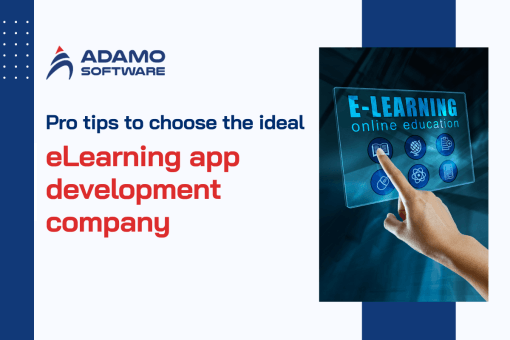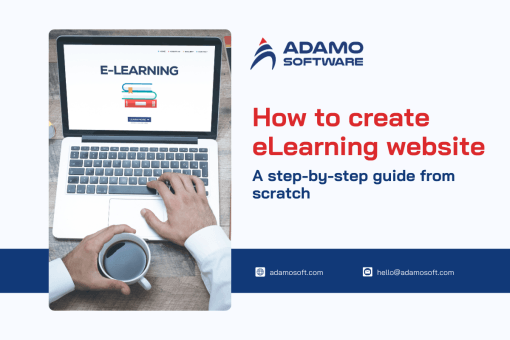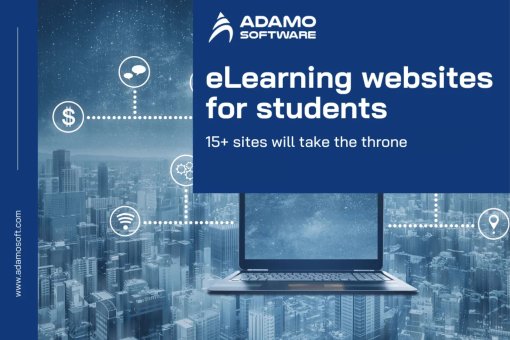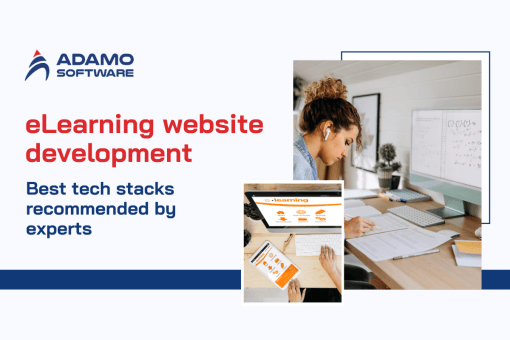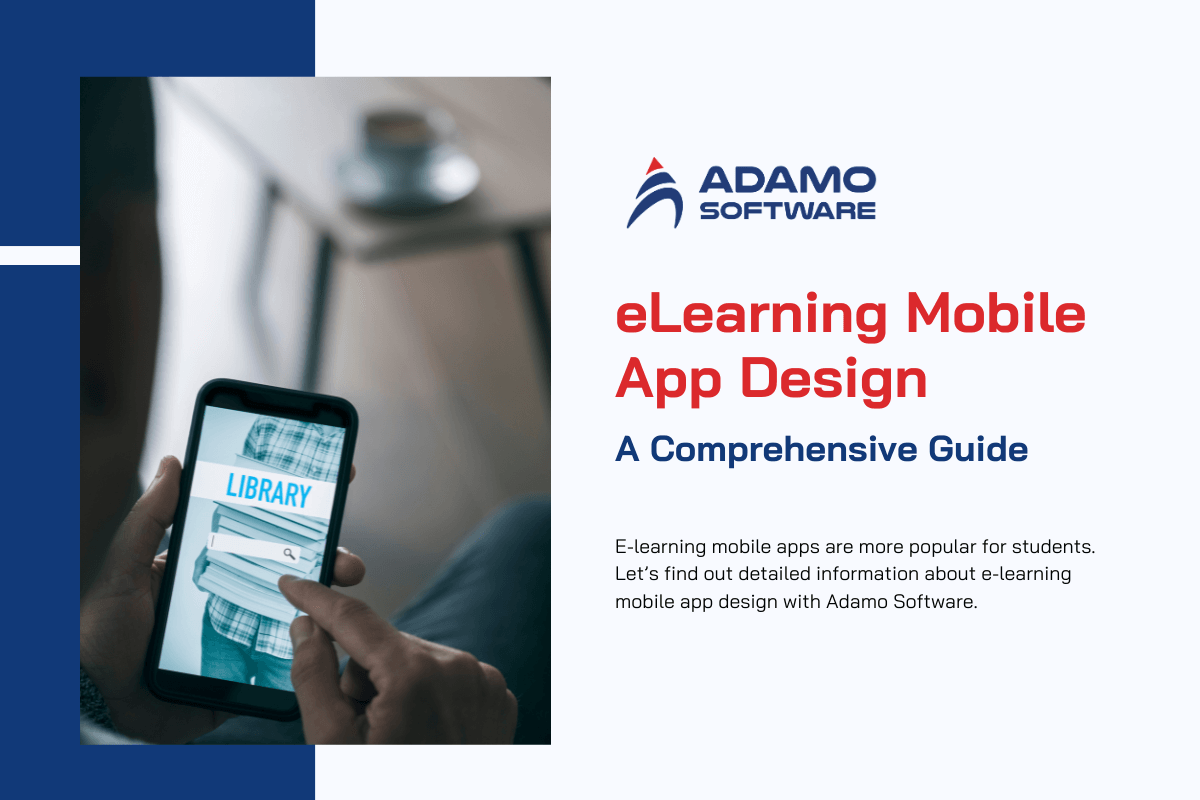
Currently, online learning is becoming more popular and widely applied. Instead of the traditional learning method with books, learners can now use their phones to learn new knowledge or review prior knowledge. As a result, more e-learning mobile apps have been created to serve online learning. Designing e-learning mobile apps; has thus become a new trend bringing many benefits to schools, academic centers, and businesses in this field. Let’s find out detailed information about e-learning mobile app design with Adamo Software.
Through this blog post, you will find the latest trends in designing education apps and key considerations for e-learning mobile app design. Besides, this blog post also details how to design a mobile e-learning application for different aims and subjects successfully. They include the design for perspective, design based on user psychology, design for educators, design for the right age, micro-learning, minimalism, convenience, efficiency, and a gaming experience. All information contained in the blog post has been carefully researched by Adamo Software, based on the trends in modern technology. So, read on for our post and find some useful information for yourself.
I. The Latest Trends in Designing Education Apps
Developing education apps in general and e-learning mobile app design in particular is an ever-evolving field. It involves staying informed about user expectations and educational theories to deliver the best user experience. Let Adamo Software introduce to you the latest trends in educational app design.
1. Integrating AI and machine learning in app design
Schools, universities, and training units use AI to personalize their online teaching roadmap to suit the learners. AI learns and analyzes user data and behaviors, identifies their weaknesses, and recommends solutions for learning institutions. Besides, it also involves understanding users’ learning progress and styles. This allows educational institutions to enhance their education management systems. In addition, they can adjust and tailor the learning experience for their users.
In addition to real teachers, AI also supports chatbots with virtual tutors providing immediate support and guidance for learners. With student progress tracking, teachers, tutors, and lecturers can identify areas students need to improve. Then, they can offer tailored support for learners.

2. Adopting Augmented Reality (AR) and Virtual Reality (VR)
Currently, learning institutions are adopting AR and VR technology in their online teaching process. These technologies allow learners to approach more educational possibilities. Virtual experiments that are inaccessible or difficult to reach in reality are now can be done. AR and VR help popularize distance learning and introduce innovative ways to understand information, increasing students’ imagination and creativity.
As the cost of AR and VR tools drops, they are now more popular in education. These technologies are changing the way learners learn with exciting ways to understand new ideas. This approach is redefining education, making learning more dynamic, interactive, and effective.
3. Gamification
Gamification is one of the simplest ways for you to add fun and excitement to your app. In addition, it is also a great way to increase user engagement. Through the games, users can reach their goals faster.
When designing an educational app, developers will incorporate elements like points, badges, leaderboards, and challenges to motivate learners. Besides, interactive simulations offering real-life scenarios are also indispensable to encourage users to learn.
4. Microlearning
Microlearning is a trend in e-learning mobile app design that developers must focus on. This helps solve the problem of not having enough time to study. The reason is that it can divide the lesson into small parts. Each part does not take too much of the learner’s time. Learners can take advantage of any free time to study without worrying about the lesson taking up too much of their time. No matter if users are on short breaks or the go, they can still engage with content.
Microlearning reinforces learning through spaced repetition. Short, focused sessions deliver timely and practical knowledge, aiding immediate application.
Overall, the above trends are shaping the future of education apps. Following these trends, developers can design an app that is more engaging and accessible to a wider audience. So what should be considered for e-learning mobile app design specifically? Let’s keep reading for more detailed information.
Also read: Everything You Must Know about e-Learning App Development Services
II. Key Considerations for E-learning Mobile App Design
When you develop an education app, you may want to carefully plan to ensure it meets the diverse needs of users. Let’s find some key considerations for e-learning mobile app design:

1. Considering user-centered e-learning mobile app design
Focusing on the user is essential for e-learning mobile app design. Ensuring user-centered interfaces and features helps learning institutions meet the needs and preferences of their users. Let’s see how to practice this approach.
- Understanding your user
User-centered e-learning mobile app design starts with researching your target users. You may want to analyze their behavior personas to create suitable learning experiences. This helps you identify their needs, interests, and challenges. Besides, you can uncover specific elements that increase their learning effectiveness and engagement with your app. This understanding is the foundation for developing relevant features and content for your e-learning mobile app.
- Intuitive interface
In the e-learning mobile app design, developers should focus on an intuitive interface with a clear and understandable navigation structure. This helps users use the app more easily without having to spend time getting used to it. To ensure aesthetics while helping users find information and features quickly, elements such as colors, icons, and fonts should be carefully selected.
With a logical layout that minimizes clutter and concise instructions, users can focus on the learning content instead of design elements. Besides, developers must ensure the interface can adapt to different screen sizes, providing a consistent experience across all devices. Overall, an intuitive and friendly interface will increase user satisfaction and encourage users to keep using the app.
- Personalization
User-centered design focuses on personalizing user experience by providing customized features. They can be adaptive learning paths, content suggestions based on learner progress and interests, etc. Personalization, as mentioned, helps the app meet individual learning needs, thereby creating higher engagement and interest in the learning process. Users may feel they are effectively supported thanks to outstanding features like adjusting the learning speed, choosing priority topics, and receiving personalized feedback.
- User Feedback
User feedback is an essential element in e-learning mobile app design, helping developers get more insights into the real-life experience of users when using the app. By integrating features that allow users to easily submit feedback, report bugs, or suggest improvements, developers can adjust and improve the app according to users’ needs. Besides, they can identify the app’s strengths and weaknesses, thereby continuously improving the interface, features, and content.
2. Content delivery
Content delivery is also a key consideration when designing the e-learning mobile app. This involves delivering interactive content, providing modular content, multi-platform content distribution, and download and offline access capabilities. Below are some insights into each factor.
- Interactive content
Engaging and interactive content are essential for e-learning mobile app design. The content must incorporate multimedia elements such as videos, images, audio, and graphics to enhance learners’ understanding and retention.
- Providing modular content
Breaking content into short modules or lessons makes it easier for users to access and grasp information. Modularizing content also allows learners to focus on specific pieces of knowledge, facilitating better review and retention. Besides, completing each small module promotes motivation and continuation in the learning process.
- Multi-platform content distribution
Your content must be provided in various formats such as video lectures, podcasts, reading materials, practice exercises, etc. This helps e-learning applications adapt to users’ diverse learning styles. The diversity in content format increases flexibility and allows users to access information in the way that best suits them, thereby improving learning efficiency. It also helps retain users longer as they can choose the learning method that best suits their individual needs.
- Download and offline access capabilities
The ability to download learning content and access it offline is an important feature that ensures flexibility and convenience for users. Your e-learning mobile app design must consider this, as it enables learners to learn anywhere, regardless of network conditions. This not only helps users make the most of their free time but also creates a seamless learning experience, without being interrupted by external factors.
In general, by focusing on providing engaging, flexible, and relevant content, e-learning applications can meet the diverse learning needs of users, thereby improving learning efficiency and overall experience.
3. Data security and privacy
Security and privacy are crucial considerations in e-learning mobile app design. When you develop your app, you must ensure that it adheres to strict data protection standards, including GDPR and COPPA, to safeguard user information and build trust. Robust security measures and data encryption are essential to safeguard user data from unauthorized access. Additionally, developers may want to integrate strong authentication mechanisms like two-factor authentication and strict access controls to ensure that only authorized users can access their accounts and data. By implementing strict data security and privacy measures, e-learning applications not only protect user information but also build trust and ensure compliance with legal regulations, contributing to creating a safe and trustworthy learning environment.
4. Cost and monetization
Cost and monetization are also important for your e-learning mobile app design. They ensure that the application is both profitable for the developer and affordable for the user. When developing the app, developers may consider the freemium model. This model offers a free version with basic features, while users can purchase additional premium plans to access advanced content and features.
In-app purchases allow users to purchase individual courses, additional content, or premium features within the app, creating a flexible income stream. In addition, developers can offer monthly or yearly subscriptions that give users unlimited access to all of the app’s content and features.
Generally, by choosing the right monetization model and managing costs effectively, e-learning apps can grow sustainably, meet user needs, and generate long-term profits for developers.
III. How to Design a Successful eLearning Mobile App
For the success of your e-learning mobile app design, you need to consider many factors to come up with the most complete app that is suitable for both teachers and learners. Here’s a guide to each of the key design principles.
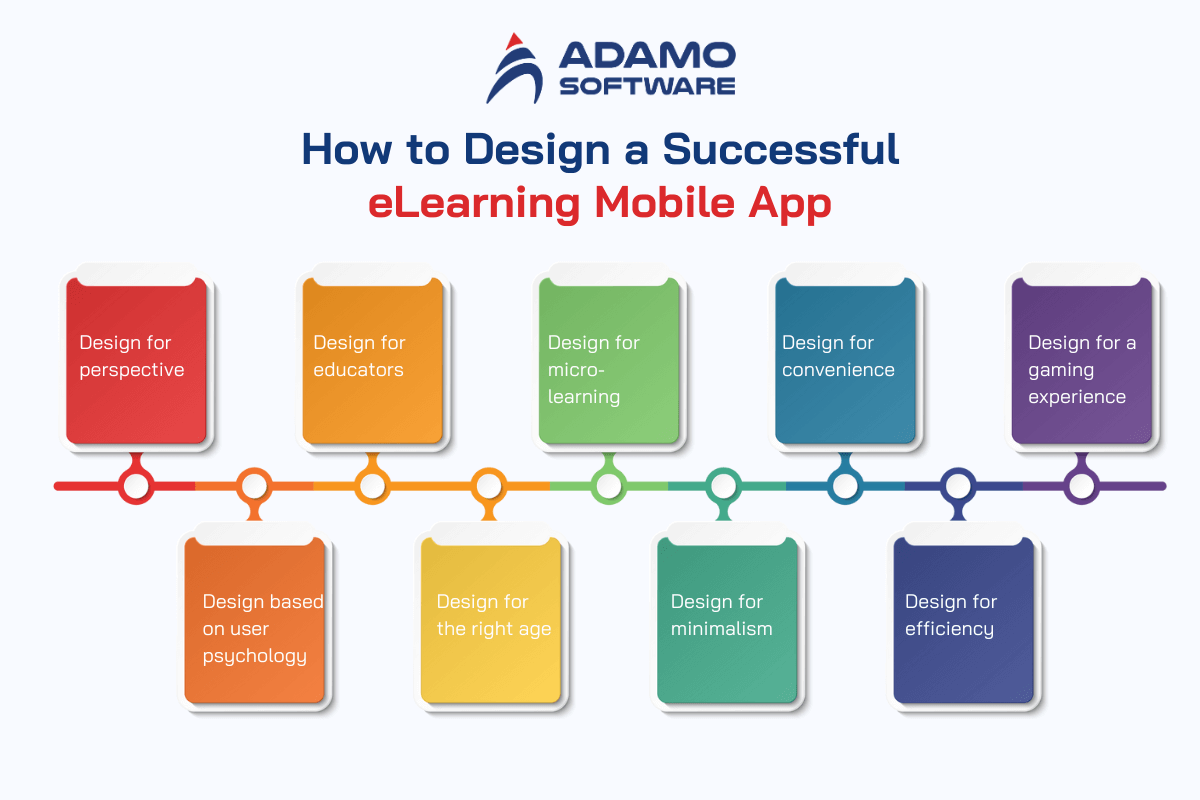
1. Design for Perspective
Designing for perspective is a key element in creating successful e-learning applications. This helps to create learning experiences that are tailored to the needs and context of the user. Your e-learning mobile app design must start by understanding usage context. You may want to study the environments and situations where users frequently use the application. They can be learning environments, devices used, and the users’ habits.
Besides usage context, cultural factors must also be focused on. You must ensure the app content and interface are appropriate for the target user’s culture, including language, customs, and other social factors. Let’s create in-app tutorials and help that are contextual to users, making it easy for them to learn and use the app in different situations.
2. Design Based on User Psychology
For e-learning mobile app design, user psychology is a key factor. It helps increase engagement, learning effectiveness, and user satisfaction. You may want to apply psychological principles such as intrinsic and extrinsic motivation to design elements that motivate users. For example, learners may feel more engaged and committed to the learning process through integrating scores, badges, and leaderboards.
According to the principles of cognitive psychology, microlearning helps users avoid being overwhelmed and makes it easier to grasp information. This approach reduces cognitive load, thereby improving the ability to absorb and retain knowledge.
3. Design for Educators
Focusing on designing for educators also contributes to the success of your e-learning mobile app design. This specific development effectively supports teachers in creating, managing, and tracking learning content. You must provide powerful and easy-to-use tools to help teachers create and edit learning content, such as lectures, tests, and assignments. Drag-and-drop features, built-in templates, and multimedia support save teachers time and boost creativity.
Through the integration of classroom management features such as progress tracking, grading, and assignment management, teachers can easily track each student’s progress and provide timely feedback.
4. Design for the Right Age
The success of your e-learning mobile app design also has the participation of designing for the right age. This ensures that the content and interface are appropriate to the cognitive abilities and needs of each age group. It’s time for you to tailor learning content to the cognitive development level of your target audience. For example, content for children should be simple, intuitive, and easy to understand, while content for adults may be more complex and require higher levels of critical thinking.
Besides the content, the user interface is also needed in designing a successful e-learning mobile app. If you target children, your app interface must have bright colors, fun images, and simple interactive elements.
5. Design for Micro-Learning
As mentioned, microlearning is a trend in e-learning mobile app design. This helps users acquire and apply knowledge through concise and manageable learning modules. Here are some key things related to this.
- Flexibility and accessibility
When developing your app, you must ensure that learning modules can be accessed and completed anytime and from anywhere. To help users learn anytime, anywhere, download or offline access options are necessary.
- Integrate interactive elements
Using interactive elements such as quizzes, practice exercises, and educational games in each module enables users to apply knowledge immediately and maintain interest.
- Encouraging continuous learning
Designing learning modules in a series or learning path can help users build a habit of regular and continuous learning. With short-term goals and rewards for completing each step, users will feel motivated to continue learning.

6. Design for Minimalism
Minimalism design is an essential principle in successful e-learning mobile app design. This helps to create a focused interface that is easy to use and to follow the content. You may want to eliminate unnecessary elements and focus on the most important parts of your app. Use white space wisely to avoid overwhelming users and help them focus on the learning content without distraction.
Besides, you should design a simple and intuitive navigation system. Minimalize menus and icons and display only what is really necessary so that users can easily find and access learning content. By keeping things simple and streamlined, e-learning applications become easier to use, more engaging, and more effective in delivering knowledge.
7. Designing for Convenience
Designing for convenience is also crucial for developing an e-learning mobile app. During your e-learning mobile app design, you must ensure that your users can access the app from different devices without any difficulty in interfaces or features. This allows students to study anytime, anywhere in the way that is most convenient for them. Besides, for the convenience of users, you may want to use notifications and reminders subtly, sending only important and relevant information to avoid intruding. This helps keep the learning process moving without feeling intrusive.
8. Design for Efficiency
Design for efficiency is also a core element in e-learning mobile app development, ensuring that users can absorb knowledge quickly and effectively. It’s time for you to design learning content that is intuitive and easy to understand, eliminating unnecessary elements so users can grasp information quickly. Clarity in presentation helps reduce confusion and improve learning.
For the efficiency of your e-learning mobile app design, you must integrate progress measurement tools into your app. They include tests, self-assessment exercises, detailed reports, etc. These tools help users realize their progress and adjust their learning methods when necessary. This helps maximize learning efficiency and achieve goals accurately. In addition, an immediate feedback feature is also needed to help users master knowledge and make adjustments. Timely feedback helps reinforce knowledge and prevent repeated mistakes.
9. Design for a Gaming Experience
As mentioned above, gamification is a trend in developing e-mobile apps. Effective design for a gaming experience also helps to design a successful e-learning mobile app. Integrating games into the lessons turns learning tasks into fun challenges. This encourages users to complete more tasks to gain rewards and progress. Let’s build learning tasks or challenges that are similar to levels in a game that users must complete to advance to the next level. These tasks can be designed to test users’ knowledge and skills interactively and engagingly.
Overall, by focusing on the above principles, your e-learning mobile app design process can be smooth and successful. Each design aspect will contribute to a holistic learning experience that keeps users motivated, supported, and returning to the app.
IV. Best e-Learning Mobile App Design at Adamo Software
As one of Vietnam’s leading app development companies, Adamo provides full-cycle services in software development, mobile and web-based solutions, AI development, and Blockchain. Partnering with Adamo, you will have your e-learning mobile app designed in the most attractive and effective ways. You can completely trust the effectiveness we commit to. As our team includes professional developers, designers, and project managers, we will closely work with you to help you with your e-learning mobile app design.

Adamo will incorporate all the necessary elements for your app. They include user-centered design, responsive and adaptive user interface, engagement through gamification, and micro-learning modules. Additionally, Adamo will ensure the data security and privacy for your app. Given the sensitivity of educational data, Adamo ensures that all eLearning apps have strong security measures to protect user data and privacy. This includes encryption, secure authentication, and compliance with data protection regulations.
Overall, the best e learning mobile app design at Adamo Software focuses on creating a user-friendly, engaging, and secure learning environment. By incorporating the latest trends and technologies, we ensure that our solutions can meet and even exceed your expectations.
Still feel confused? Let’s contact us for the best plan for your e-learning mobile app design!






